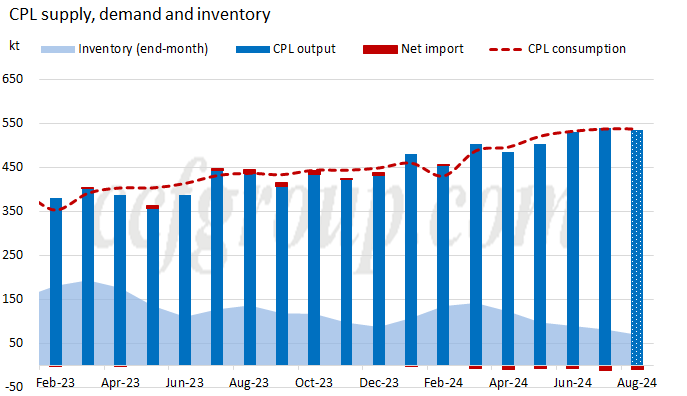An estimation of CPL supply and consumption in September
Entering the traditional peak season, CPL and nylon 6 market has recently shown a lackluster performance. A significant part of the reason is the pressure from the new caprolactam plants coming online.
According to the latest news, the new plant from Sanning is expected to start producing next week (early Sep), and at the same time, Hualu Hengsheng's CPL new plant will also restart next week(early Sep). Additionally, starting this week, Luxi Chemical's Phase III new plant will ramp up its operating rate, heightening market concerns about increased CPL supply. Thus, negotiations of both CPL and nylon 6 chip have entered a stage of waiting and observation. In fact, apart from the restart of these two major plants, there have also been some other fluctuations in CPL and nylon 6 chip plants.
| CPL company | Capacity (kt/year) | Production plan |
| Hubei Sanning | 400 | To yield product in early Sep, to run at 70% |
| Hualu Hengsheng | 400 | Capacity expands after restart |
| Lubao Chemical | 100 | To shut on Sep 5, but nylon 6 production may not shut with high possibility |
| Luxi Chemical | 300 | Restarted, ran at 70% |
| Nylon 6 company | Capacity (kt/year) | Production plan |
| Hubei Sanning | 140 | 70*2, gradually start up in H1 Sep |
| Luxi Chemical | 50 | line 8, to restart on Sep 10 |
| Luxi Chemical | 250 | phase III, elevate run rate, calculated as 70kt/year |
| Jiahua | 35 | To start up in early Sep |
| Weiming | 100 | To gradually restart in H1 Sep |
| Shenma Puli | 70 | To start up in end-Sep |
From the perspective of CPL commodity circulation, since the launch of Phase III plant, Luxi Chemical has limited its participation in East China's CPL trading. On one hand, the nylon 6 chip has seen increased capacity, and cyclohexanone and the new CPL units have not been running at full capacity. Therefore, during the period of plant operational changes, they have relied more on their own inventory to bridge the gap, with limited involvement in East China CPL market. After both upstream and downstream of Luxi restart in September, it is expected that there will not be much impact on East China CPL market. Thus, the analysis of CPL supply and demand is focused on other factories.
The calculations indicate that the incremental supply of CPL is 580,000 tons, while the nylon 6 chip increment is 345,000 tons. This means that there is an excess supply of 235,000 tons of CPL, which translates to a net monthly increase of about 20,000 tons.
So what is the current level of absolute inventory?

According to CCFGroup statistics, by the end of August, the total CPL inventory has decreased to approximately 65,000 tons, which is the lowest level this year. Based on the operating rate at the end of August, it still shows a slight inventory reduction state, meaning that the actual accumulation of CPL in September is less than 20,000 tons.
Through quantitative analysis of the CPL supply and demand relationship in September, CCFGriyp's basic conclusion is that there will be a slight accumulation at a relatively low absolute inventory level, but the total inventory at the end of September is still not high.
Even so, we understand that from the perspective of price trading, the market is more focused on expectations and marginal changes. The amount of accumulated inventory is not important. What matters is the qualitative aspects of the accumulation, which determines which side dominates the negotiation. This has also been a key reason for the subtle changes in CPL prices since last week. This week, the market has started to lean towards the buyers, with East China price of 12,800yuan/mt showing signs of weakness.
Although there are expectations of accumulation, both supply and demand sides still need to pay attention to several key issues:
1. The restocking demand in South China market.
2. The probability of benzene strengthening. Based on experience, Shandong benzene is closer to the actual market, while East China benzene tends to lean more towards commodity trading. Recently, East China market has seen a significant discount to Shandong, widening the price gap. There is a chance of narrowing this price difference in the future.
3. For the tightening CPL resources in the fourth quarter, as a significant amount of CPL stock has been consumed in September, the subsequent restocking demands from polymer plants may lead to new changes in CPL situation.
4. The rebound of bulk commodities may resonate with concentrated transactions of nylon 6 chips, thereby promoting the transaction of CPL.
- Top keywords
- Cotton Price
- Cotton Futures Price
- Cotton Futures
- CZCE
- PTA Futures Price
- Chemical Fiber
- Polyester Prices
- Wool price
- PTA Futures
- Shengze Silk
- China
- Yarn Price
- price
- China Textile City
- Fibre Price
- Benzene Price
- Cotton
- Index
- Cotton Index
- PTA
- fabric price
- NYMEX
- Top 10
- textile industry
- Spot Cotton
- Cotton Yarn
- Polyester Price
- Futures
- PTA Price
- cotton yarn price

